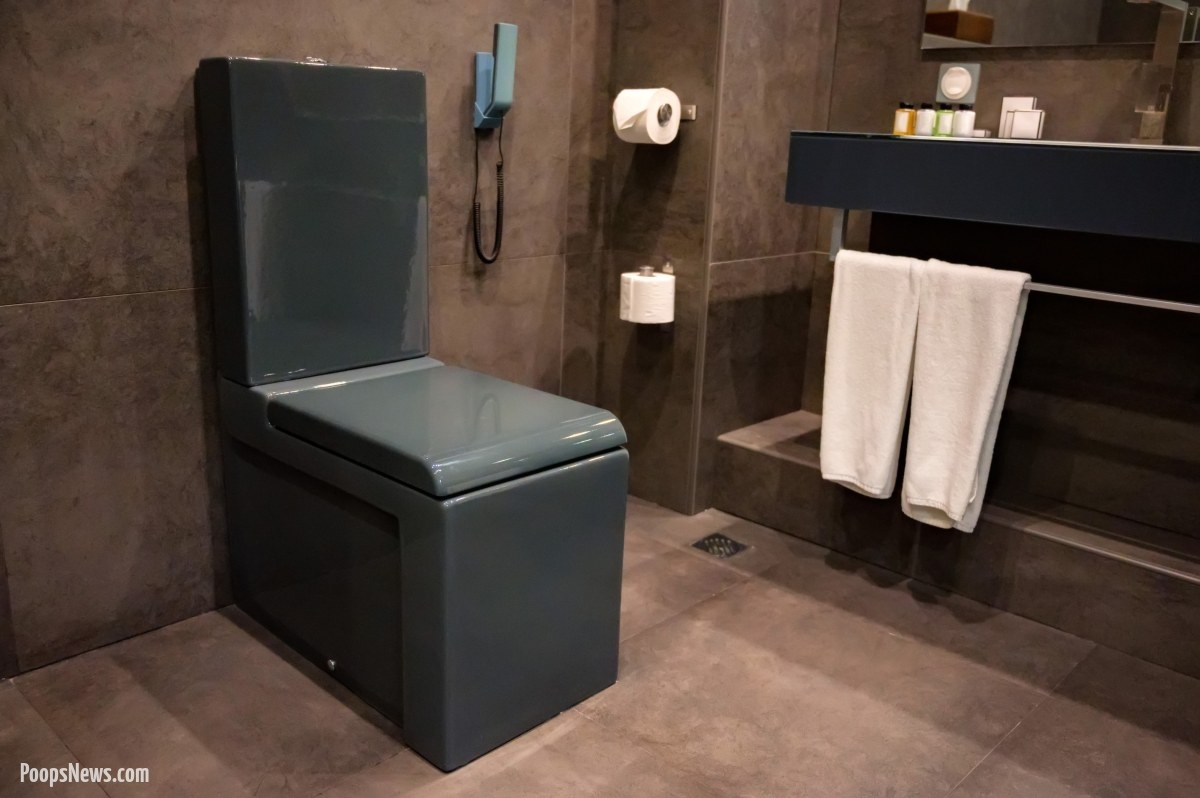In a bold move to combat climate change, save water, and make mornings infinitely more complicated, a new line of ‘Eco-Flush’ toilets has hit the market, revolutionizing the way we, as a society, engage in the ancient ritual of flushing. The concept is simple: one person, one toilet, one flush per day. No exceptions. No do-overs. Just pure, unadulterated eco-friendliness. After all, why should we waste precious water when there’s no need for all that unnecessary flushing?
The Birth of the ‘Eco-Flush’ Movement
For decades, environmentalists have been pushing for water conservation, warning us that our reckless toilet habits are draining the planet dry. In response, engineers — possibly the same ones who brought us such innovations as biodegradable paper straws that disintegrate in your hands — have turned their attention to what they believe is the core of the problem: our obsessive desire to flush after every visit to the porcelain throne.
The ‘Eco-Flush’ toilet is the brainchild of a team of environmental scientists, engineers, and, probably, people who only drink kombucha. Designed to limit each user to a single daily flush, this toilet is hailed as the future of sustainability. Gone are the days of water-wasting double flushes. Forget about courtesy flushes. And don’t even think about the dreaded mid-day “emergency flush” after a spicy burrito. The future is one flush, and you better make it count.
How It Works
The technology behind the ‘Eco-Flush’ toilet is as sophisticated as it is merciless. The system uses state-of-the-art sensors to recognize each unique user’s… posterior. Once registered, it allows exactly one flush every 24 hours. A small green light on the toilet confirms when your flush is available, much like the elusive check engine light that seems to mock you from the dashboard of your car.
If you attempt to flush a second time within that 24-hour period, the toilet simply refuses. It’s like being ghosted by your own bathroom fixture. No amount of pleading, crying, or bargaining will change the fact that your flush quota has been exhausted for the day. Think of it as an extreme lesson in water conservation. Want to flush again? You’ll just have to wait until tomorrow, or perhaps reconsider your dietary choices.
The Environmental Impact
Proponents of the ‘Eco-Flush’ toilet claim it will save billions of gallons of water annually, making it a cornerstone of the global effort to fight climate change. Critics, meanwhile, argue that the technology is a bit extreme — after all, one flush a day seems… a tad draconian. But supporters dismiss these concerns, saying it’s about time we face the realities of our planet’s water crisis head-on. And what better way to do that than by limiting the average human’s ability to flush away their problems?
Reports suggest that people living in dry, arid regions — where water is worth its weight in gold — are embracing the ‘Eco-Flush’ with open arms, or perhaps clenched cheeks. Water-saving zealots see this as a badge of honor, a personal sacrifice they make in the name of Mother Earth.
One environmental advocate proudly announced, “I used my one flush today at 8 a.m., and now it’s 2 p.m., and I’ve never felt closer to nature! Literally”. She gestured to the small forest that now thrives in her backyard, fertilized by what can only be described as the “composting movement”.
Real-Life Scenarios: The True Test of Patience
While the environmental benefits are clear, the societal implications are… fascinating. It turns out that limiting people to a single daily flush introduces a variety of unexpected challenges — many of which the designers never quite anticipated.
Take the modern family, for instance. With multiple people sharing a bathroom, families are now forced to make strategic decisions about when and how to use their precious flush allowance. Gone are the days of carefree flushing after every small task. Now, households must coordinate flushes like military operations. Some parents have even turned to creating Excel spreadsheets to determine who gets the flush priority on any given day.
Family conflicts have escalated to unprecedented levels. One father, speaking anonymously for fear of retribution from his flush-deprived children, said, “Yesterday, I had to choose between using my flush or giving it to my 8-year-old. It was the hardest decision of my life”.
Couples, too, are feeling the strain. One man revealed, “My girlfriend used her flush right after breakfast, and by the time dinner rolled around, it was like a scene from a horror movie. We argued about who gets to flush tomorrow. I never thought I’d see the day when a toilet would test our relationship”. There’s even a growing trend among couples to set up “flush schedules”, with some opting to take turns every other day, demonstrating the ultimate sacrifice for love and, apparently, plumbing.
The New Etiquette
As ‘Eco-Flush’ toilets become more mainstream, so too does the need for a new brand of bathroom etiquette. In public restrooms outfitted with these water-saving devices, people have started leaving apologetic notes on stall doors after reaching their flush limit for the day. “Sorry! Out of flushes — use at your own risk!” reads one note in a particularly brave downtown café.
Sharing a bathroom at work has never been more complicated. Imagine the scene: you’re on your lunch break, hoping to quickly relieve yourself before a big meeting. You approach the restroom, only to be confronted by a coworker sheepishly emerging from the stall, their eyes downcast as they mutter, “I used my flush already”.
Awkward? Yes. A brilliant icebreaker? Perhaps.
Even restaurants and coffee shops are beginning to adjust their policies. Some establishments now warn patrons before seating them, “We limit guests to one flush per person per meal. Choose wisely”. Predictably, this has resulted in a rise in takeout orders.
Extreme Measures: Planning Ahead
For those who refuse to accept their one-flush fate, extreme times call for extreme measures. Some crafty individuals have devised ingenious ways to bypass the system. Tales abound of people sneaking into neighbors’ homes, libraries, and even hotel lobbies, desperately seeking access to an unguarded toilet to achieve that sweet, sweet second flush.
Meanwhile, a lucrative black market for flushes has emerged in some urban centers. Flush dealers lurk in alleyways, offering to “unlock” an additional flush for a small fee. Rumor has it that flush-for-cash schemes are on the rise, with some individuals willing to trade anything for just one more flush. After all, what’s a flush worth?
The Future of Toilets
While it may seem like we’ve reached the peak of toilet innovation, rest assured, this is only the beginning. Visionary ‘Eco-Flush’ engineers are already hard at work on the next iteration of water-saving technology: the “No-Flush” toilet. That’s right — why stop at one when you can stop at zero?
The ‘No-Flush’ toilet concept takes things a step further, embracing a more “natural” approach to human waste. It’s essentially a very chic hole in the ground, designed to foster a deeper connection between you, your bodily functions, and the earth itself. Early adopters are already touting the ‘No-Flush’ as the next frontier in sustainable living, though critics are, understandably, skeptical.
A Flush Too Far?
The ‘Eco-Flush’ toilet represents a bold step forward in the fight against climate change, albeit one that asks a lot of its users. Is it a sacrifice worth making? That’s up to you — and your bladder — to decide. What we can say for certain is that the ‘Eco-Flush’ revolution is here, and it’s already flushing away old habits and bringing a whole new meaning to the phrase “doing your business”.
In the words of one ‘Eco-Flush’ enthusiast, “It’s not just about saving water — it’s about rethinking the way we live. Also, I may need to rethink my lunch choices”. Indeed, if this movement teaches us anything, it’s that in the quest for sustainability, every flush counts.





